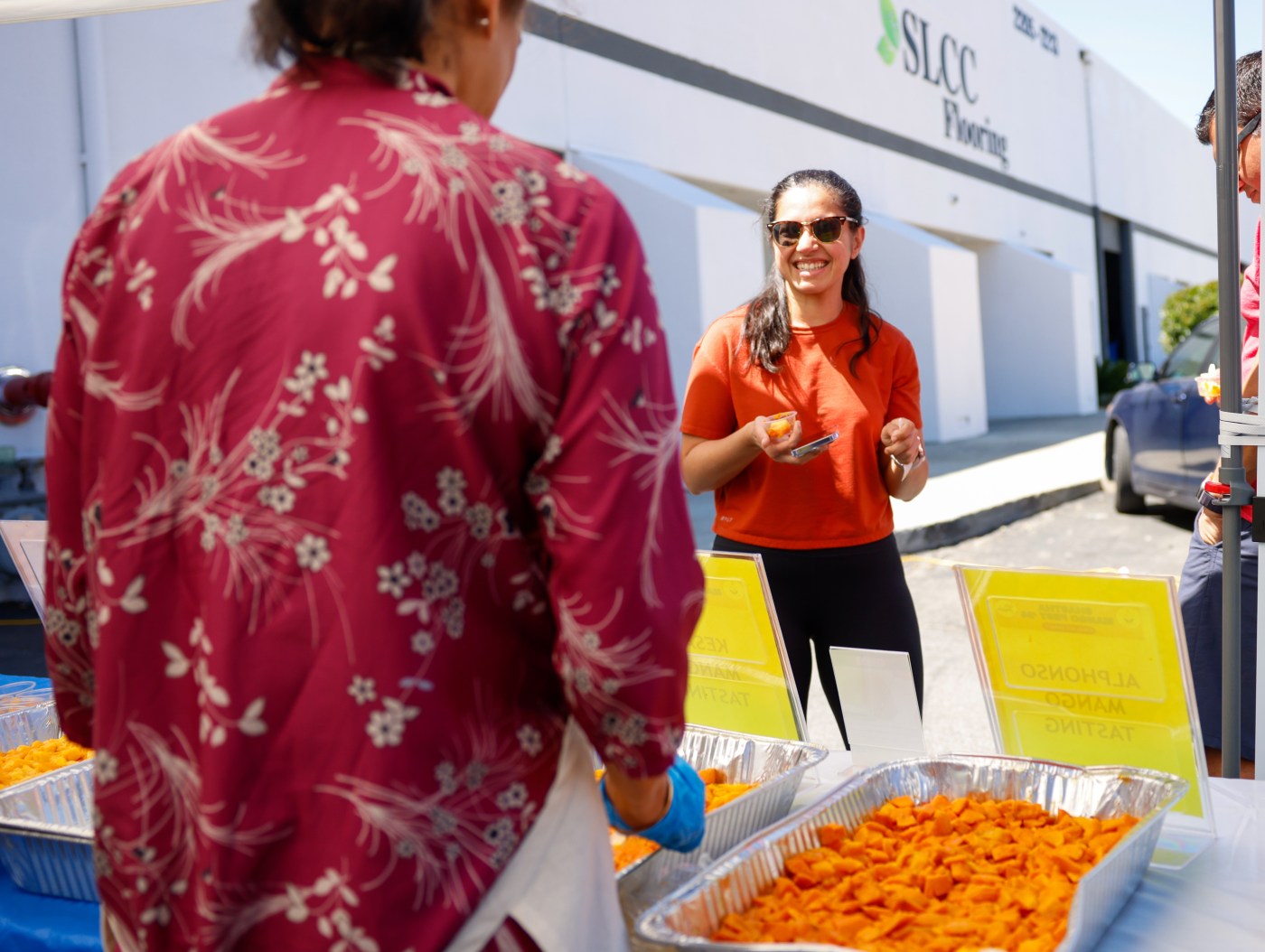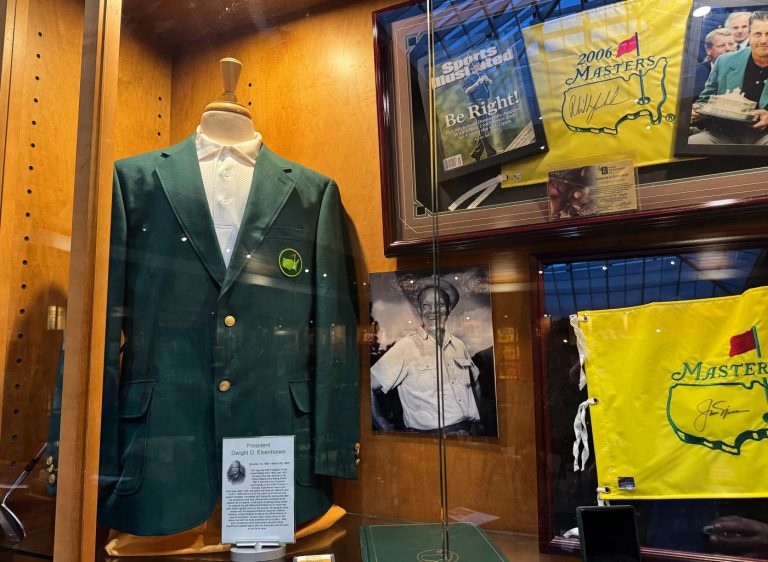These days, mangoes cost about $1 each at your local grocery store. Often sourced from the Philippines or Mexico, they’re increasingly common in stores this month as the fruit comes into season.
But at 2205 Ringwood Ave. in San Jose, you’ll find boxes of mangoes on sale for five times as much; generally $50 for a box of 10, but even more for certain varieties. And they’re flying off the shelves.
These aren’t just any mangoes. They’ve been hand-picked, packaged and transported nearly halfway around the world — from India.
The sudden influx of Indian mangoes into the South Bay is thanks to Shastha Foods, a San Jose-based Indian foods company with a logo familiar to many South Asian American kitchens.
Syamala Raghuram, Co Founder and president, holds a mango at Shastha Fresh, the delivery arm of the Indian foods company Shastha Food, in San Jose, Calif., on Tuesday, May 7, 2024. Shastha has been importing 10+ varieties of Indian mangoes to sell to customers in the South Bay and beyond, and the demand is high. (Shae Hammond/Bay Area News Group)
The company has been importing Indian mango varieties for customers across the West Coast over the past three years. It supplies a large number of Indian grocery stores, and its products can even be found in Costco.
But even Shastha wasn’t prepared for this new wave of “mango mania” that saw more than 1,100 people lined up on Sunday outside Shastha’s North San Jose warehouse for what the company calls “Mangofest,” where they provide free in-person tastings of the imported Indian mango varieties that the company stocks and sells from its warehouse.
Mangoes are a source of pride for Indians and the Indian diaspora. They’re a staple in the Indian diet for the hot summer months that they’re in season and an ever-present memory when they’re not. Often described as the “king of fruits,” they grow easily given the country’s tropical climate and exist in roughly 1,500 distinct varieties in India, the Times of India reported.
Kesar and alphonso mangoes, for example, are native to India’s western region; the bright yellow kesar are both sweet and sour, while the tangerine-colored alphonso are bigger, smoother and almost buttery in taste. And the green and red South Indian rajapuri mango is even bigger, more sour and softer in texture, compared to the almost egg-shaped green-yellow rasalu mango that’s smaller, more fibrous and juicy.
Shastha has roughly 14 varieties of Indian mangoes available on its website and is providing many of those varieties for people to sign up and taste at their events, depending on which ones are ready to eat.
Syamala Raghuram, co-founder and president of Shastha Fresh, the company’s food delivery arm, said they began the tastings after hearing about a demand for Indian mangoes from Indian grocery store customers.
Syamala Raghuram, co-founder and president of Shastha Foods, center, helps sell mangoes at Shastha Foods in San Jose, Calif., on Friday, May 10, 2024. (Shae Hammond/Bay Area News Group)
“The mango, I cannot just call it a fruit, it is more of an emotion with Indians,” she said.
The company plans to continue hosting the weekly tastings until the end of mango season in late June, Raghuram said.
The huge turnout for the events is due, at least in part, to the influence of local Instagram celebrity Ronil California. California, who uses a pseudonym because of his visa status, posted an Instagram reel about an in-person mango tasting that Shastha was hosting at its warehouse on May 5 for the 83,000 followers on his page @californiaaa_baybae.
Hours later, the post had gotten 100,000 views and continued to climb to the 1.2 million mark by the day of the event. By the time the warehouse doors opened on May 5, lines of buyers wrapped around the building, and Teslas circled the lot looking for parking.
Local Instagram celebrity who goes by “Ronil California” at his home in San Jose, Calif., on Tuesday, May 7, 2024. (Dai Sugano/Bay Area News Group)
California, who is from the state of Maharashtra in India, features Desi restaurants and Airbnbs on his Instagram page, and posts content geared toward a South Asian audience. He said the company asked him to promote the events they host, such as the mango tasting, because of his large following.
Inexpensive mangoes typically available at American supermarkets often pale in comparison to Indian varieties, as they can be crunchy, sour or stringy, missing the familiar sweetness and bite that many South Asians know and love.
What many people of Indian descent are showing up to Shastha looking for, said California, is the experience of picking a sun-warmed mango off a tree, cutting it open and eating the fruit without bothering to slice and peel it, juice running down your chin.
“It’s a childhood memory for everyone back in India for the summer season,” he said.
It wasn’t always easy to find Indian mangoes in the U.S., especially when they were banned here in 1989 over concerns about pests spreading to American crops. Finally, when former U.S. President George W. Bush visited India in 2006 to work with then-Prime-Minister Manmohan Singh on a nuclear pact between the two countries, they agreed to a nuclear-arms deal.
Also part of the deal? A trade agreement that resulted in lifting the ban on the importation of the famous fruit.
“The United States is looking forward to eating Indian mangoes,” Bush famously said on his trip.
The agreement paved the way for the Bay Area’s sizable Indian population to access the beloved fruit. As of 2023, Indian-born residents made up the largest immigrant group in both Alameda and Santa Clara counties — a total of 250,000 residents.
Related Articles
It’s opening weekend for cherry season in the Bay Area; here’s where to go
Here are the ultraprocessed foods you most need to avoid, according to a 30-year study
Oakland McDonald’s employees hold rally over rat invasion
Santa Clara County’s new food systems manager is looking to raise awareness about how everything is connected to food
Your fridge is a place where fresh food goes to die. That doesn’t have to happen
California said part of what makes Shastha’s event so special is that it brings so many mango varieties all in one place — something that even Indian people living in India don’t often get to experience.
Raghuram said Shastha’s goal is to create that experience for everyone, whether they’re South Asian or not.
“Like each region has its diversity of people in India, likewise mangoes are diverse, the taste and the flavor is totally diverse,” she said. “We wanted to instill that flavor with the Americans as well.”
Those interested in attending mango tastings can join the list on the company’s Eventbrite page.












